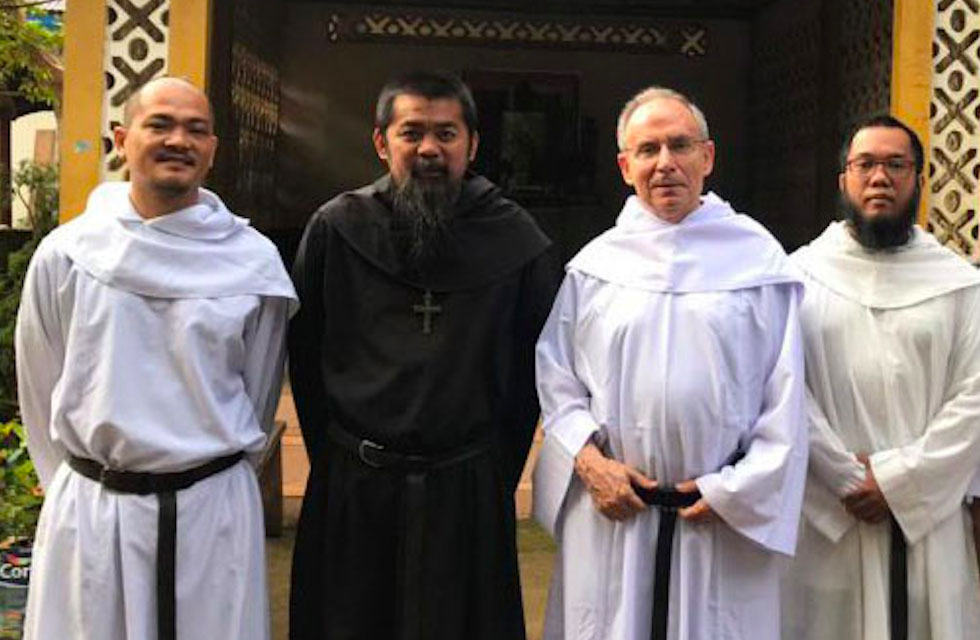Let us Pray for missionaries around the world
•October 4, 2022

Fray Dennis Castillo, OAR, Fray Jess Marco Sanchez, OAR, Fray Miguel Miró, OAR (Prior General), and Fray Kenneth Caligdong, OAR, during the fraternal visit
of the Prior General to the community of Recoletos de Kamalo.
Let us Pray for missionaries around the world, but most specially for the great Spanish missionaries who journeyed with us in our 500 years of Christianity–to them our grateful hearts go.
- During my talk a week ago at the first CBCP-initiated dialogue between the Church and the government under BBM, I was blessed to have shared breakfast and be seated in front of Very Rev. Lino Greg Redoblado, OFM, Father Provincial of the Franciscans in the Philippines. [Topic of the dialogue is separate from this reflection].
- Among many things we’ve talked about was the founding of Franciscan parishes across the archipelago. As soon as they arrived, the FIRST FRANCISCANS in their brown habits established schools and hospitals, and built bridges, roads, and dams. Evangelization and socio-human development were the twin goals of the missionaries.
- I in particular marvel at the Sta. Ana Church in Manila, dedicated to Nuestra Señora de los Desamparados, the first parish founded by the OFM in 1578, when their habits still carried the brackish smell of the ocean after crossing the Pacific. I was born in Sta. Ana more than 60 years ago.
- It’s called immersion. From the 1600s through the 1800s, the pioneering missionaries of Augustinian, Franciscan, Dominican, Jesuit, and Recolletos Orders (OSA, OFM, OP, SJ, and OAR) opted to figure out and imbibe the Filipino culture, immersed themselves with different ethnological tribes, learned and talked in various Philippine dialects, and used them to touch people’s lives.
- Hence, it was not surprising to hear Spanish friars speaking in Kapampangan, Ivatan, Cebuano, Ilongo, or Ilocano, almost similar to listening to the late Spanish Dominican Father Jesus Prol or Argentinian Father Luciano Felloni speaking in Tagalog.
- And they did more. They founded great Catholic universities and colleges, trained and sent thousands of lay catechists to evangelize our people in the frontiers or corregimientos.
- They toiled to civilize the uncivilized and humanize the dehumanized, not to forget how Nick Joaquín associated the plow and the carabao with the frayles Españoles, Spanish Friars, in the most pragmatic way.
- The combo of the plow and the carabao has revolutionized the Philippine agriculture, and in the words of Joaquin in IKON, FRIAR AND CONQUISTADOR (2004):
- “The revolution here can be appreciated if we imagine that most typical of Philippine scenes: a carabao pulling a plow. We think this ‘immemorial,’ but it isn’t. The pre-Hispanic carabao was a meat, now a work animal. Tilling, planting, and gathering were all done by hand, which necessarily limited what a farmer could produce.
- “The (Spanish) friar brought wheel and plow here and he turned the carabao into a draft animal, to pull the plow, to pull the cart. This lifted a mountain of labor off the farmer’s back and expanded his ability to produce.”
- THE EARLY SPANISH MISSIONARIES WERE WALKING MESSENGERS OF GOD. Hear what Spanish historian Tomas de Comyn has recorded:
- “Of little avail would have been the valor and constancy with which Legazpi and his worthy companions overcame the natives of the islands, if the apostolic zeal of the missionaries had not seconded their exertions…” (1821).
- The gentle character of the Spirit-filled evangelizers in general did the real conquest of the islands and the submission of the islanders. The OSA, OFM, OP, SJ, and OAR missionaries “were the real conquerors; they who without any other arms than their virtues, gained over the good will of the islanders…”
- As Comyn has nicely put it: The Spanish missionaries “gave the king, as it were by a miracle, two million more of submissive and Christian subjects.”
- The so-called Christian praxis, coupled with a daily dosage of Biblical stories, was the best teacher of all. Was it Mahatma Gandhi who adhered to the powerful principle: “An ounce of practice is worth more than tons of preaching”?
- French physician and historian Jean Mallat de Bassilan (1808-1863) studied the situation of his time and, underscoring the importance of Christian praxis and the good example shown by the friars, summarized his findings in one line:
- C’est par la seule influence de la religion que l’on a conquis les Philippines, et cette influence pourra seule les conserver. “It is through the influence of religion alone that the Philippines has been conquered, and this influence alone can preserve them.”
- I bless God Almighty for in several decades of my life I had the privilege to have met saintly Spanish missionaries: Dominican Fathers Javier Arrazola, Merino, and Pablo Fernandez; Salesian, Jesuit, Franciscan, Augustinian Missionaries — among them.
MABUHAY ANG MGA MISIONEROS!
